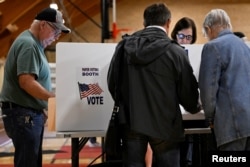History suggests the Democratic Party’s narrow control of both houses of Congress — the Senate and House of Representatives — could end after the midterm elections in November.
But the conservative Supreme Court ‘s unpopular decision to end the constitutional right to an abortion for women could be the catalyst that bucks history.
“Historically, the president’s political party has almost always lost seats in Congress in the midterm elections,” says Mark Rozell, dean and professor of policy and government at George Mason University in Virginia. “So, if this were just a normal, ordinary midterm election year, we would expect the Republicans to make very significant gains, particularly given that not only the historical pattern favors the Republicans, but there’s a relatively unpopular Democratic president.”
Midterm elections occur halfway through a president’s four-year term. All 435 seats in the House of Representatives — where members serve two-year terms — and 35 of 100 Senate seats are up for grabs. Across the country, seats in many state legislatures and about half of the nation’s governorships are also on the ballot.
Buoyed by Democratic control of Congress, President Joe Biden has recorded a string of legislative victories and signed bills into law strengthening gun restrictions, overhauling America’s infrastructure, fighting climate change and limiting drug prices. The results of the midterms will impact his ability to continue implementing his agenda for the country over the second half of his term.
“The majority [party in Congress] controls who gets appointed to what committees, and … they’re going to determine what things are going to come to the floor,” says Mary Brennan, professor of history and dean of the College of Liberal Arts at Texas State University. “Assuming that the opposite party from the president’s party is in control, they can stall the president’s agenda.”
Historical perspective
Over the past century, the president’s party picked up seats in the midterms only three times. First, in 1934 during the Great Depression when Franklin Delano Roosevelt was commander in chief; in 1998 after the impeachment of President Bill Clinton; and in 2002, shortly after the 9/11 terror attacks.
“In each of those three cases, there was very strong support for the incumbent president: The Great Depression in 1934. The unpopularity of the Clinton impeachment that had been led by the Republicans. And then George W. Bush had stratospheric popularity in 2002 after the attack on 9/11,” Rozell says. “So, those are three really extraordinary circumstances. And in the past 100 years, in every other midterm election, the party in control of the White House lost seats, and usually a significant number.”
Voter turnout for the midterms is usually significantly lower than during presidential elections. Fifty-three percent of eligible voters voted in 2018, but that was the highest midterm turnout in four decades. In 2014, just 41.9% of eligible voters cast a ballot during the midterms, while 66.8% of eligible citizens voted in the 2020 presidential election.
“The reason the midterms don’t usually go the way of the party that’s in power is because their supporters are satisfied, and so they stay home,” Brennan says. “And the people who are unhappy and riled up are the ones who turn out during the midterms.”
What voters will weigh
Republicans hope voters will punish Democrats for decades-high inflation, economic uncertainty, uncontrolled migration across the U.S.-Mexico border, America’s chaotic withdrawal from Afghanistan and other factors. Democrats hope their record of accomplishment in Washington and the continued prominence of former President Donald Trump in national headlines will energize their core supporters and drive them to the polls.
“We do have some circumstances in this election cycle that are quite unusual that could drive voting decisions in a different-than-usual direction,” Rozell says. “These are the things that history can’t pick up… The Supreme Court’s abortion decision may be just that example this year. That may have changed the dynamics of a number of congressional races this year that are highly competitive in favor of Democrats, because the Supreme Court decision is highly unpopular throughout the nation.”
Brennan says more mundane, hard-to-gauge factors will also come into play during midterm voting this November.
“People tend to think it doesn’t make as much difference. It’s not a presidential election. They haven’t seen all the campaigns. They don’t know,” she says. “It could also be something like the weather. It could be, ‘It’s raining. I can’t go out in this. It’s too hot. I can’t stand in the line.’ It could be, ‘I don’t have a ride to the polls, and are they going to close before I get off work?’”


